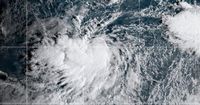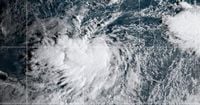As the calendar turns to October, the Pacific hurricane season is once again commanding attention—especially for travelers and residents in Baja California Sur and the resort city of Los Cabos. On September 30, 2025, forecasters at the National Weather Service in Miami announced the formation of Tropical Storm Octave, a system that, while currently far from land, serves as a vivid reminder of the region’s vulnerability during this time of year.
According to the Associated Press, Tropical Storm Octave was centered about 930 miles (1,500 kilometers) south-southwest of the southern tip of the Baja California peninsula as of Tuesday. The storm packed maximum sustained winds of 40 mph (65 kph) and was inching northwest at a slow 5 mph (7 kph). At this stage, no watches or warnings were in effect, and Octave posed no immediate hazards to land. Forecasters did not expect significant strengthening for the next few days, but noted the potential for intensification toward the end of the week.
Meanwhile, in the Atlantic Ocean, a different story was unfolding: hurricanes Humberto and Imelda were making their approach toward Bermuda, raising concerns for that island territory. But for Baja California and Los Cabos, it’s Octave and the broader Pacific outlook that have local authorities and the tourism sector on alert.
The Cabo Sun reports that Los Cabos Civil Protection has been particularly vocal about the risks that accompany the first half of October. Francisco Cota Márquez, the director of Civil Protection, recently cautioned that “wind patterns and high ocean moisture in early October historically align with the region’s stronger, wider tropical cyclones—hence the call to be very alert during the first and second weeks of the month.” While there’s no guarantee any storm will make landfall, officials say the odds of a direct impact rise during this window.
It’s a message echoed by both meteorologists and local authorities: the Pacific basin is active, and even storms far offshore can prompt rapid changes in local conditions. Octave itself, while not an immediate threat, is a clear signal that the season is far from over. The National Hurricane Center’s Eastern Pacific outlook continues to show late-season activity, and advisories for Octave are a reminder to remain vigilant.
For visitors and locals alike, this means a mix of preparation and calm. The good news, according to The Cabo Sun, is that most major resorts in Los Cabos have robust backup power systems and have refined their hurricane protocols in recent years. Even during brief grid wobbles in Cabo San Lucas, hotels along the Tourist Corridor have managed to keep operations running smoothly, while some neighborhoods experienced only short outages. This reliability is one reason many travelers prefer resort accommodations during storm season.
Moreover, Los Cabos has strengthened its coordination with U.S. officials and the hotel sector, ensuring that hurricane alerts and guidance are disseminated quickly and in English when needed. This partnership aims to reduce confusion and provide smoother shelter-in-place plans if a system does approach the coastline. As The Cabo Sun notes, “that partnership is designed to reduce confusion long before a system is near the coastline.”
So, what practical steps can travelers take as they navigate the heart of hurricane season? Local authorities and travel experts recommend a few straightforward measures:
First, bookmark official sources for weather updates. The National Hurricane Center (nhc.noaa.gov) and local Civil Protection channels provide the most reliable forecasts and track guidance. Los Cabos municipality posts hurricane-season bulletins on its official pages and social media before, during, and after weather events.
Second, know your hotel’s procedures. Upon check-in, ask how the property handles watches and warnings, where interior meeting points are located, and how you’ll receive updates—whether by room phone, WhatsApp, or door notices. Many resorts proactively review these details with guests during peak season.
Third, stay flexible with your activities. Ocean conditions can shift even when a storm is far offshore. After heavy rains, health officials sometimes advise against entering the ocean until water quality returns to normal. Expect similar short-term guidance after major runoff or swells, and don’t be surprised if boat tours or water activities are temporarily paused.
Packing for the season is also key. Quick-dry layers, a light rain jacket, and footwear with good grip can make a world of difference if arroyos swell or sidewalks become slick. A small flashlight and portable charger are handy additions, especially for those lodging outside major resorts where blackouts may be more common.
Finally, have a contingency plan. Ask your airline and hotel about change-fee policies if watches or warnings are posted. Many properties will allow guests to shift dates when authorities issue formal alerts, providing valuable flexibility if conditions change unexpectedly.
If a watch or warning is issued during your stay, Los Cabos hotels coordinate closely with Civil Protection and tourism leaders. Guests may be asked to move to interior hallways or event spaces for a short period while outer storm bands pass. Restaurants often operate on adjusted schedules, and organized activities are paused. The goal, as officials emphasize, is “minimal disruption with maximum safety—then a quick return to normal once conditions improve.”
It’s not just about safety; it’s also about the region’s remarkable resilience. The Cabo Sun has reported on how quickly tourism rebounds after storms, with beaches reopening and cleanup efforts kicking into high gear as soon as it’s safe. In fact, the local tourism industry has made it clear that the message to travelers is not to cancel, but to be informed, stay flexible, and follow property and official guidance. “For most travelers, the takeaway isn’t ‘cancel’—it’s be informed, stay flexible, and follow property and official guidance,” the outlet advises.
As for Octave, the coming days will determine whether the storm intensifies or fizzles out at sea. For now, there are no hazards affecting land, and forecasters are watching closely for any changes. But the broader lesson is clear: early October is a higher-risk slice of the Pacific hurricane season, and both officials and the hospitality sector are right to raise awareness.
In the end, a little preparation and a lot of common sense go a long way. By keeping an eye on official updates, understanding hotel protocols, and packing smart, travelers can enjoy the beauty of Los Cabos while respecting the power of the Pacific. The tropics may be busy, but with the right information and a flexible mindset, vacations can stay on track—even when the weather has other plans.


